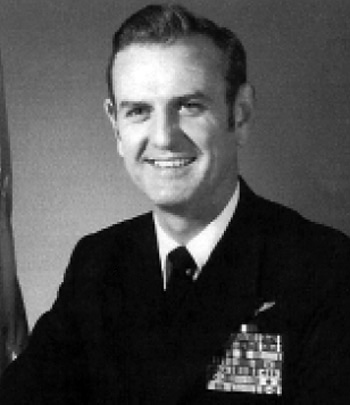
|
James B. Linder |
 |
|||
| Rank, Service | ||||
Rear Admiral O-8, U.S. Navy |
||||
| Veteran of: | ||||
|
||||
| Tribute: | ||||
Jim Linder was born on October 13, 1925, in Osceola, Iowa. He enlisted in the U.S. Navy on May 19, 1943, and served until October 31, 1943. Linder later entered the U.S. Naval Academy in 1945 and received his commission as an Ensign in the U.S. Navy on June 3, 1949, serving aboard the aircraft carrier USS Franklin D. Roosevelt (CV-42) from June to September 1949. He then attended flight training and was designated a Naval Aviator in December 1950, followed by service with Fleet Aircraft Service Squadron 7 at NAS San Diego, California, from January to May 1951. LT Linder flew F9F-2B and F9F-5 Panthers and later F9F-6 Cougars with VF-112 from May 1951 to April 1954, and during this time he flew combat missions in Korea from the aircraft carrier USS Philippine Sea (CV-47) between December 1951 and August 1952. He was stationed at NAS Willow Grove, Pennsylvania, as a Flight Training Officer from April 1954 to March 1957, and then attended additional training at NAS Glynco, Georgia, until September 1957. His next assignment was as ship's crew aboard the aircraft carrier USS Franklin D. Roosevelt from September 1957 to July 1959, followed by Naval War College from August 1959 to June 1960. CDR Linder completed A4D Skyhawk training at NAS Jacksonville, Florida, with VA-44 from July to December 1960, and then served as Operations Officer and Executive Officer of VA-172 at NAS Cecil Field, Florida, from December 1960 to June 1962. He next served a tour with the Bureau of Personnel, serving as a Legislative Assistant and then as an Aide to the Chief of Naval Personnel from July 1962 to July 1964, followed by Replacement Pilot training with VA-43 at NAS Oceana, Virginia, again flying the A-4 Skyhawk, from August to December 1964. CDR Linder then served as Executive Officer and then Commander of VA-76 from December 1964 to October 1966. During this time he flew numerous combat missions in Vietnam between October 1965 and June 1966, followed by service with Carrier Air Wing 12 from October 1966 to February 1967. CAPT Linder was Commadner of Carrier Air Wing 15 from February 1967 to May 1968, where he again flew combat missions in Southeast Asia from August 1967 to February 1968. He served another tour at the Bureau of Personnel from July 1968 to September 1969, and then served as a Senior Naval Aide to the Assistant Secretary of the Navy for Manpower and Reserve Affairs from September 1969 to March 1971. CAPT Linder was Commanding Officer of the combat stores ship USS Sylvania (AFS-2) from June 1971 to September 1972, followed by service as Commanding Officer of the aircraft carrier USS Forrestal (CVA-59) from October 1972 to May 1974. He served as Assistant Vice Chief of Naval Operations/Director of Naval Administration from May 1974 to June 1975, followed by service as Commander, Carrier Group 4 from July 1975 to July 1977. ADM Linder was Commander, U.S. Taiwan Defense Command from July 1977 to April 1979, and then served as Special Assistant to the Commander-in-Chief of Pacific Command from May 1979 until his retirement from the Navy on August 31, 1979. He died on April 7, 2009, and was buried at the Forest Home Cemetery in Mount Pleasant, Iowa. |
||||
|
||||

